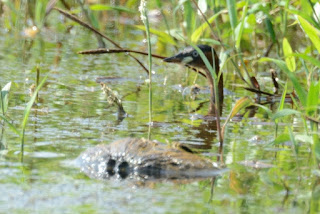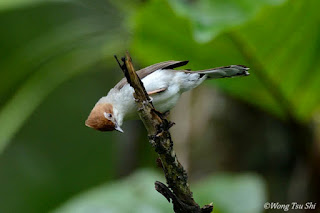Black-winged Stilt Himantopus himantopus is a common migrant from the north to northwest coast of Borneo, especially abundant in fresh and brackish water wetlands. Hundreds of them can be seen in groups in paddy fields in Tampasuk Plain and Penampang, Sabah during the northern winter months.
Black-necked Stilt (
White-headed Stilt)
Himantopus leucocephalus, a similar looking bird but for its black nuchal mane, is a scarce migrant from the south. Seen on rare occasions among groups of Black-winged Stilt.
However, as some Black-winged Stilts can exhibit plumage patterns showing black nuchal mane similar to Black-necked Stilt, as highlighted by
Sifu Dave Bakewell in his article published in BirdingASIA 17, page 14-17, great care must be taken to lay claim on sighting of Black-necked Stilt.
Identification by call can also be made if both species are together and their calls can be heard, Black-winged Stilt has a comparatively higher pitch yelping call.
Size
In Susan Myers' fieldguide, she lists both species as between 35-40 cm, which essentially says they are of similar size.
Phillipps' fieldguide says Black-necked Stilt is larger at 37cm compare to Black-winged at 32cm.
Mark Brazil says Black-necked Stilt is marginally larger than Black-winged Stilt.
Craig Robson says Black-necked Stilt is 35cm while Black-winged Stilt is 37.5cm.
Sifu Dave Bakewell states Black-necked is marginally smaller in BirdingASIA's article.
As the fieldguides have differing sizes, I'll accept that they sizes vary both ways.
Appearance
These two birds were photographed on 26th August 2012 in Tinagat, Tawau. One is a Black-winged in breeding plumage while the other has all the features of a Black-necked.
From the first photo, where two of them are almost side by side, we can see that the Black-necked (bird on the left) is overall smaller than the Blacked-winged, taking into consideration that the Black-necked is nearer to the camera, the differince in size is even more pronounced.
We cannot use bill shape for identification as the bill can be varied from straight and upcurve slightly as evidenced by comparing photos of different Black-winged Stilts.
We can also see that the Black-necked Stilt is displaying a well developed black nuchal mane, has perfect white on its crown and ear-coverts, without any visible trace of grey or black. Any existance of traces of grey or black on the crown and ear-coverts would have suggested that this is a Black-winged Stilt showing plumage of a Black-necked Stilt, as reported by Sifu Dave Bakewell in his BirdingASIA article.
Smaller Black-necked Stilt on the left

Black-necked Stilt
Pure white crown and ear-coverts
I therefore believe this is a Black-necked Stilt.
Observation
These two were seen foraging together, always close to each other, away from a small flock of Black-winged Stilts on the other side of the foraging ground. When they flew off when we were too near, they landed in another spot, also close to each other, away from the larger flock as well.
The Black-winged is in breeding plumage, and if the other bird is indeed a Black-necked than they might be in courtship, as these two species are believed to hybridise over their overlapping range.
Here is a short video of the pair.
Happy birding.
Additional reference : BirdingASIA Number 17, June 2012.


















































